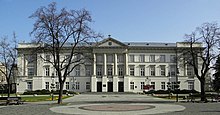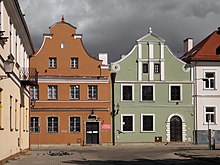Jacek Malczewski Museum
 Main building (partial view) |
|
| Data | |
|---|---|
| place | Radom , Poland |
| Art | |
| opening | March 18, 1923 |
| management |
Leszek Ruszczyk (since 2020)
|
| Website | |
The Jacek Malczewski Museum ( Polish: Muzeum im. Jacka Malczewskiego w Radomiu ) is an art museum in Radom in the Masovian Voivodeship in Poland . It is also the city's historical museum and has departments for archeology and natural history . It has been named after the Radom artist Jacek Malczewski since 1999 .
location
The building is located in the Miasto Kazimierz (Kasimir's City) district , which is named after Casimir the Great . At the elongated market square (Rynek) the museum takes up part of the south side. Opposite are the town hall from 1848 and two baroque houses that have been a branch of the museum since 1991. Most of the buildings on the square are listed buildings .
history
Collections of the Polskie Towarzystwo Krajoznawcze
The first exhibitions in Radom were shown in the government building between 1845 and 1856. This included paleontological, geological, ornithological and zoological collections. Special objects were paintings by Rubens and Rembrandt.
In December 1913, a well-known Radom collector, the priest Jan Wiśniewski, donated part of his collections to the Polish Society for Regional Studies Polskie Towarzystwo Krajoznawcze (PTK), which at that time supported the establishment of regional museums . The local branch of the town of Radom committed itself to founding a museum within a year, otherwise Wiśniewski could claim his donation back. With the outbreak of World War I , the collection was distributed to private individuals.
Between 1921 and 1923, the Society for Regional Studies reassembled the stored collections. On March 18, 1923, the first regional museum opened in a room of the government building, the then Starostei . After two years the facility was moved to the Palais Hempel. A branch of the Warsaw Music Academy was established there in 1929. After the opening of the Fabryka Broni , the museum moved to a large apartment block of the national arms factory by March 1930. Its director Kazimierz Ołdakowski became president of the PTK. Among its members, Sznuro took care of archeology , Neuman of numismatics , the painter Trzebiński of ethnography and K. Marx of the library. After the rooms became too small, the city administration made a large building available, formerly the residence of the starosts.
After the German invasion of Poland , the collections that had been unsupervised due to the war were moved to today's Żeromskiego Street 9. The Generalgouvernement dissolved the PTK in July 1940 and confiscated its property in July 1942. Stanisław Trzebiński was able to make an inventory of the collections, then he was deported to the Auschwitz concentration camp and murdered there the following year. From July 1942 the museum showed "curiosities", exclusively to German visitors. The Wiśniewski collection from 1913 was almost entirely scattered and looted.
Municipal Museum and Regional Museum

After the German withdrawal in January 1945, the collection was reorganized. More suitable rooms were found in the Kulczycki Palace (Piłsudskiego 12), built in 1892 . The Bank Handlowy had expanded it in 1906 to a second floor. In the Second World War it served as a telecommunications office. After the renovation in May 1945, the museum moved to this building and opened on October 21, 1945 with an exhibition on Polish painting. The house was subordinate to the city council. Dr.-Ing. JW Paszkowski. The museum had six employees (their number rose to ten in 1947) and an area of 660 square meters.
Four years later, the Ministry of Culture and Art took over the Municipal Museum. In addition to the Powiat Radomski , it looked after the Powiate Iłżecki , Konecki , Kozienicki and Opoczyński . It had the task of building up collections, carrying out and publishing scientific works and regional studies, and protecting monuments. The Świętokrzyskie Museum in Kielce was in charge of supervision .
After reforms in the administration, it came under the municipal administration again in 1958. In 1964 it was expanded and renamed the Regional Museum. After the educational (1952) it received an archaeological department in 1964 and an ethnographic department in 1965. From 1969–1971 it was the seat of the city conservator. The former St. Wenceslas Church was added as a location in 1964, which had housed a prison until 1920 and, after a period as an epidemic hospital, the hospital's psychiatric department. The archaeological collection and workshop moved there in 1965.
Okręgowe Museum
With the creation of the Radom Voivodeship , the Regional Museum was converted into a District Museum ( Muzeum Okręgowe w Radomiu ) in July 1975 . Tomasz Palacz took over the position of director. The Ministry of Culture and Art was again responsible. It now also had to cover the natural history area and the areas of neighboring voivodeships. On July 1, 1976, the museum received the building of the former after six years of effort Piaristen - College (Rynek 11) with an area of over 4,500 square meters.
The natural history department was set up in 1977 and the numismatic cabinet was added in 1982. In contrast, the ethnographic collections were given to the Muzeum Wsi Radomskiej (Museum of Radom Village), which opened in 1977 . St. Wenceslas went to the episcopal curia in 1978 and, after seven years of renovation, was given the appearance of a church again. The Jan Kochanowski Museum in Czarnolas and a museum in Zwoleń , which were transferred to the city administration in 1989, were added as branches . After renovations, the archaeological department was reopened in 1987. The scientific and educational department moved from the Kulczycki Palace in 1990. This became the voivodeship library in 1992 and the city library in 1999. In 1992, Radom took over the restoration workshop from the Museum of Folk Music Instruments in Szydłowiec . The museum has held major exhibitions since the late 1980s, some of which were recognized in competitions for the Museum Event of the Year .
After the Radom Voivodeship, which had existed since 1975, became part of the Masovian Voivodeship in 1999, the museum lost its national status and was renamed the Jacek Malczewski Museum. It is still controlled by the Warsaw Ministry.
The urban and regional history department was expanded from 2002 to 2005 with a family collection donated by Andrzej Pinno. On October 24, 2008, the newly restored south wing of the building, which today houses the natural history department, was ceremoniously opened. From February 14, 2020 the Jan Kochanowski Museum in Czarnolas will be an independent institution.
Contemporary Art Museum
The Museum of Contemporary Art ( Muzeum Sztuki Współczesnej ) was founded as a further branch at the end of 1990 . In 1991 it moved to the houses Gąski and Esterki (Rynek 4 & 5). According to a proposal by the founder of numerous works, Andrzej Wajda , the city should build an exhibition pavilion in the city park Stary Ogród in order to expand the capacities of the two small houses. In January 2004, however, an idea was presented in the local Gazeta Wyborcza to adapt the construction of the former Radom power station , built in 1900, for the purposes of a new art center. The idea met with great support, including Wajdas. The Mazowieckie Centrum Sztuki Współczesnej "Elektrownia" (MCSW "Elektrownia", Mazowia Center for Contemporary Art "Kraftwerk" ) project was implemented between 2011 and 2014 after an architectural competition .
The city and voivodeship's collections of around 4,500 works of contemporary art have been transferred to the new museum. The houses Gąski and Esterka were closed to visitors for renovation work on July 1, 2018 (as of May 2020). The Radom Society of Friends of Fine Arts (Towarzystwo Przyjaciół Sztuk Pięknych w Radomiu) also had its seat in the buildings.
- management
- JW Paszkowski, 1945–1952
- Anna Apanowicz, 1952–1974
- Tomasz Palacz, 1975-1983
- Barbara Hrynkiewicz, 1983-1984
- Janusz Pulnar, 1984 to 2006
- ?
- Adam Zieleziński, 2008–2019
- Leszek Ruszczyk, since 2020.
description
The museum's fine arts section has approximately 28,000 objects. The works of the painters of the “Munich School” (Szkoła monachijska) and those of the “Young Poland” with Leon Wyczółkowski and Jacek Malczewski are of importance. Nikifor is one of the special lay and naive artists .
structure
- archeology
- history
- City and regional history
- Military history
- Numismatic cabinet
- Department of Nature
- Department of Ancient Art
- Lay Art Department
- Scientific and educational department
- Artistic and technical department
- Restoration workshop
- Service departments
Other museums with works by Malczewski
- National Museum of Wroclaw
- Museum in Rogalin , branch of the National Museum in Poznan
- Museum of Kuyavian and Dobrin Land in Włocławek
Web links
- muzeum.edu.pl: Museum website (Polish)
- muzeum.edu.pl: O Muzeum. (Polish, History of the Jacek Malczewski Museum)
- mcswelektrownia.pl: Historia Elektrowni. (Polish)
literature
- Mazovia Center for Contemporary Art “Kraftwerk”. In: Ewa Kutyła: Walk through Radom . 3rd edition, Radom 2015. pp. 48–49.
Individual evidence
- ↑ Ewa Kutyła: walk in Radom . 3rd edition, Radom 2015. p. 44.
- ↑ Ewa Kutyła: walk in Radom . 3rd edition, Radom 2015. p. 46.
- ↑ Ewa Kutyła: walk in Radom . 3rd edition, Radom 2015. p. 12.
- ↑ Ewa Kutyła: walk in Radom . 3rd edition, Radom 2015. pp. 36–37.
- ↑ Decision No. 78 of the Committee of the Council of Ministers for Culture and the Arts of October 6, 1949.
- ↑ Ewa Kutyła: walk in Radom . 3rd edition, Radom 2015. p. 5.
- ↑ Established by Decree No. 11 of the Radom Voivodeship of July 1, 1975.
- ↑ Ewa Kutyła: walk in Radom . 3rd edition, Radom 2015. p. 37.
- ↑ Established by Ordinance No. 109/90 of the Radom Voivod of November 10, 1990.
- ↑ muzeum.edu.pl: Godziny otwarcia. (Polish, accessed May 27, 2020)
- ↑ According to the sandstone plaque to the right of the entrance door. (Last updated 2012)
Coordinates: 51 ° 24 '9.4 " N , 21 ° 8' 31.8" E






